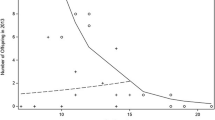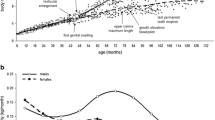Abstract
Five hypotheses that related female rank and reproductive success were tested in an intact troop of free-ranging, provisioned, Japanese macaques. The hypotheses stated that high-ranking females (1) begin parturition earlier in life than low-ranking females; (2) produce more offspring than low-ranking females; (3) give birth during some optimal time during the birth season to a greater extent than low-ranking females; (4) experience less infant mortality than low-ranking females;and (5) more frequently produce male offspring, while low-ranking females more frequently produce female offspring. A statistical analysis of the data which included three birth seasons and 55 adult females and 34 pubescent females, all of known age, rank, and matrifocal membership in the Arashiyama B troop, revealed few significant results. An association was found between the rank of the matrifocal unit and the age of first birth. However, the relationship was the reverse of hypothesis 1, i.e., females of the lower-ranking matrifocal units began parturition earlier than females of higher-ranking matrifocal units. Therefore, in this troop of Japanese monkeys— where alternative feeding strategies existed— there was little association between female rank and reproductive success.
Similar content being viewed by others
References
Altmann, J. (1980).Baboon Mothers and Infants, Harvard University Press, Cambridge, Mass.
Cheney, D. L., Lee, P. C., and Seyfarth, R. M. (1981). Behavioral correlates of non-random mortality among free-ranging female vervet monkeys.Behav. Ecol. Sociobiol. 9: 153–161.
Dickemann, M. (1979). Female infanticide, reproductive strategies, and social stratification: a preliminary model. In Chagnon, N. A., and Irons, W. (eds.),Evolutionary Biology and Human Social Behavior: An Anthropological Perspective, Duxbury Press, Mass.
Drickamer, L. C. (1974). A ten-year summary of reproductive data for free-rangingMacaco mulatto.Folia primatol. 21: 61–90.
Dunbar, R. I. M., and Dunbar, E. P. (1977). Dominance and reproductive success among female gelada baboons.Nature (Lond.) 266: 351–352.
Hamilton, W. D. (1967). Extraordinary Sex Ratios.Science 156:477–488.
Hanby, J. P., Robertson, L. T., and Phoenix, C. H. (1971). The sexual behavior of a confined troop of Japanese macaques.Folia primatol. 16: 123–143.
Hrdy, S. (1977).The Langurs of Abu, Harvard University Press, Cambridgy, Mass.
Hull, C. H., and Nie, N. H. (1981).SPSS Update 7–9, McGraw-Hill, New York.
Koyama, N. (1967). On dominance rank and kinship of a wild Japanese monkey troop in Arashiyama.Primates 8:189–216.
Koyama, N. (1970). Changes in dominance rank and division of a wild Japanese monkey troop in Arashiyama.Primates 11: 335–390.
Noyes, M. J. S. (1982). Dominance relations within large extended kinship groups in a troop of Japanese monkeys. Paper presented at the AAPA meetings, Eugene, Oregon.
Robinson, J. G. (1982). Intrasexual competition and mate choice in primates.Am. J. Primatol. (Suppl.) 1: 131–144.
Rowell, T. E., and Richards, S. M. (1978). Reproductive strategies of some african monkeys.J. Mammal. 60(1): 58–68.
Silk, J. B., Samuels, A., and Rodman, P. S. (1980). Rank, reproductive success, and skewed sex ratio inMacaca radiata.Am. J. phys. Anthropol. 52(2): 279.
Takahata, Y. (1980). The reproductive biology of a free-ranging troop of Japanese monkeys.Primates 21 (3): 303–329.
Trivers, R. L., and Willard, D. E. (1973). Natural selection of parental ability to vary the sex ratio of offspring.Science 179:90–91.
Wolfe, L. D. (1981). The reproductive history of a hybrid female (Macaco mulatto xMacaca fuscata).Primates 22(1): 131–134.
Wolfe, L. D., and Noyes, M. J. S. (1981). Reproductive senescence among female Japanese macaques (Macaca fuscata fuscata).J. Mammal. 62(4): 698–705.
Author information
Authors and Affiliations
Rights and permissions
About this article
Cite this article
Wolfe, L.D. Female rank and reproductive success among arashiyama B Japanese macaques (Macaca fuscata). Int J Primatol 5, 133–143 (1984). https://doi.org/10.1007/BF02735737
Received:
Revised:
Issue Date:
DOI: https://doi.org/10.1007/BF02735737




